Hormonal acne in women over 40 often results from aging-related hormone shifts, like decreased estrogen and increased androgens, which boost oil production and clog pores. Conditions like PCOS and stress can worsen these breakouts, while menopause and treatment options like birth control and medications can help balance hormones. Adopting a gentle skincare routine, managing stress, and making lifestyle changes can improve your skin. To learn more about tailored solutions, keep exploring how you can address these changes effectively.
Key Takeaways
- Hormonal fluctuations due to aging, menopause, or PCOS increase oil production, causing breakouts in women over 40.
- Decreased estrogen and increased androgens stimulate sebaceous glands, leading to persistent or cystic acne.
- External factors like stress and diet can exacerbate hormonal acne in mature skin.
- Effective treatments include hormonal therapies, topical retinoids, and lifestyle changes to restore hormonal balance.
- A gentle skincare routine with sun protection and healthy habits can help manage and prevent hormonal breakouts.
Understanding the Prevalence of Hormonal Acne After 40
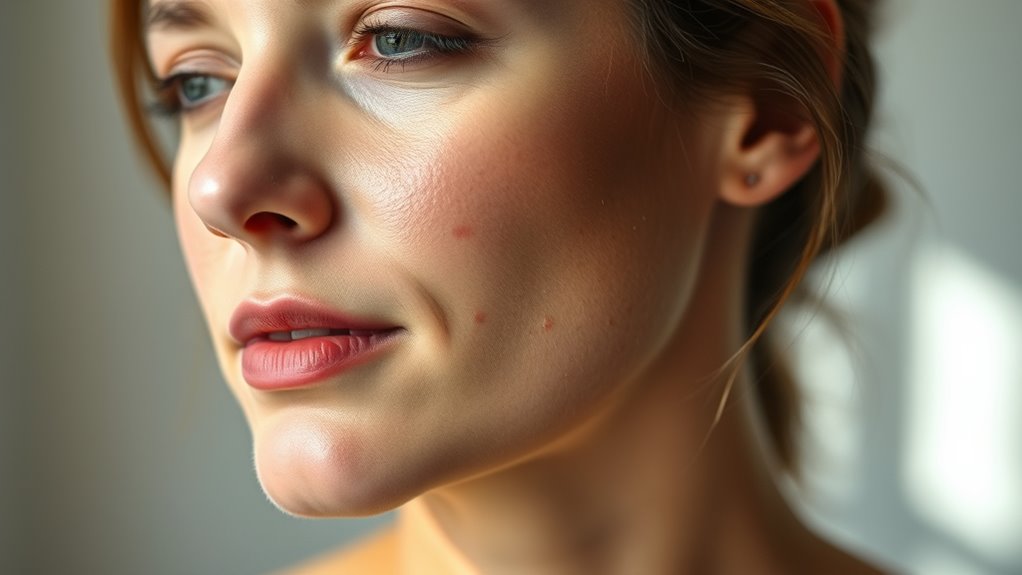
Hormonal acne remains a common concern for women over 40, affecting approximately 25% of women in their 40s. Despite decreasing with age, this type of acne remains a significant issue, especially because many cases go underreported or receive inadequate treatment. You may notice that acne persists or even worsens during this stage, influenced by hormonal fluctuations. While only about 5% of women between 40 and 49 experience general acne, the hormonal variant is particularly more prevalent. Factors like family history, lifestyle choices, and hormonal shifts contribute to its persistence. Globally, acne is the eighth most common disease, emphasizing its widespread impact. Understanding how prevalent it is helps you recognize that you’re not alone and highlights the importance of seeking appropriate treatment. Recognizing that hormonal fluctuations play a crucial role can help in developing targeted strategies for management. Additionally, awareness of age-related hormonal changes can aid in early detection and tailored skincare approaches. Recognizing the role of hormonal imbalances can also lead to more effective treatment options and lifestyle adjustments. Moreover, hormonal regulation through lifestyle adjustments or medical interventions may significantly improve skin health during this stage. Staying informed about dynamic communication exercises for couples can also support overall emotional well-being during hormonal changes.
How Hormonal Changes Contribute to Acne Development
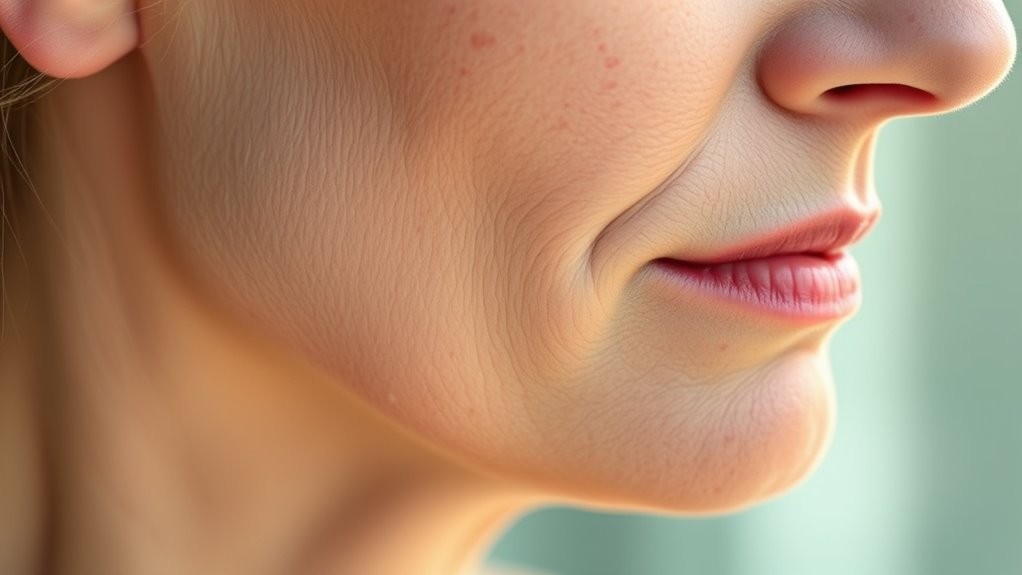
Fluctuations in hormone levels during perimenopause are the primary drivers behind hormonal acne in women over 40. As estrogen declines, androgen levels rise, stimulating your sebaceous glands to produce more oil. This excess oil combines with dead skin cells, clogging pores and creating the perfect environment for acne to develop. You might notice blackheads, whiteheads, or inflamed bumps forming on your face. These changes can be intensified by external factors like stress, diet, or skincare products that block pores.
- Imagine your skin becoming more oily, with pores clogging like tiny drains.
- Visualize bacteria trapped in stubborn blockages, triggering redness and swelling.
- Picture hormonal shifts causing unpredictable breakouts, from subtle bumps to painful cysts.
The Impact of Menstrual Cycles and Pregnancy on Skin Health
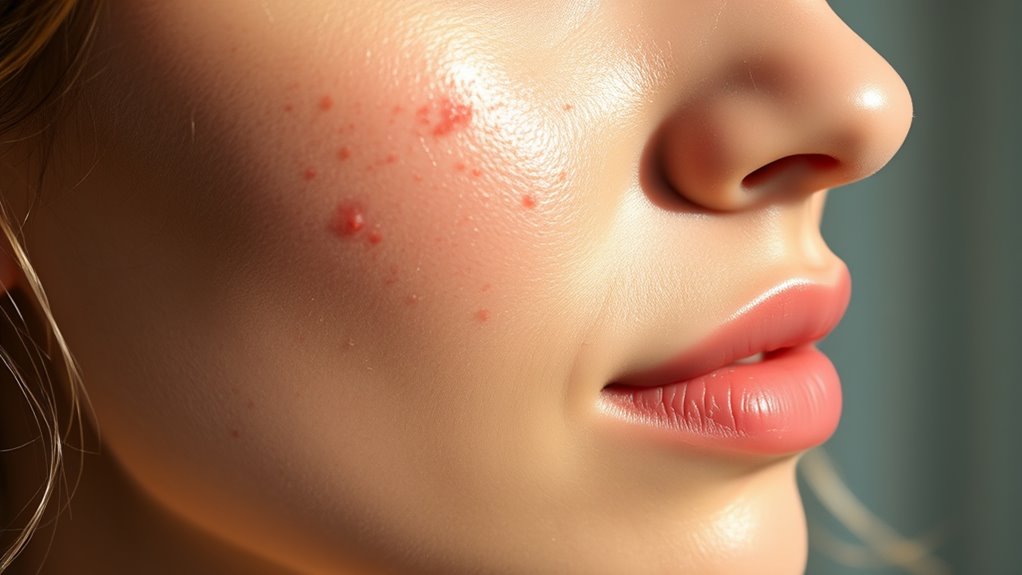
Your skin responds dynamically to the hormonal shifts that happen during your menstrual cycle and pregnancy. During your cycle, fluctuating estrogen and progesterone levels cause changes like increased oil production, which can trigger breakouts before and during menstruation. You might notice dry, sensitive skin during your period due to lower hormone levels. Pregnancy brings significant hormonal shifts, with elevated estrogen and progesterone, often leading to a glowing complexion and better hydration. However, it can also cause melasma, hyperpigmentation, and stretch marks because of rapid skin stretching and hormonal influence. These changes can affect your skin’s texture and elasticity. Understanding hormonal fluctuations can help you better anticipate and address skin changes during these times, especially when considering skincare adjustments tailored to your hormonal cycle. Being aware of these natural hormonal effects can also aid in choosing appropriate skincare products that support your skin’s health during these periods.
Conditions That Increase Risk: PCOS and Genetics
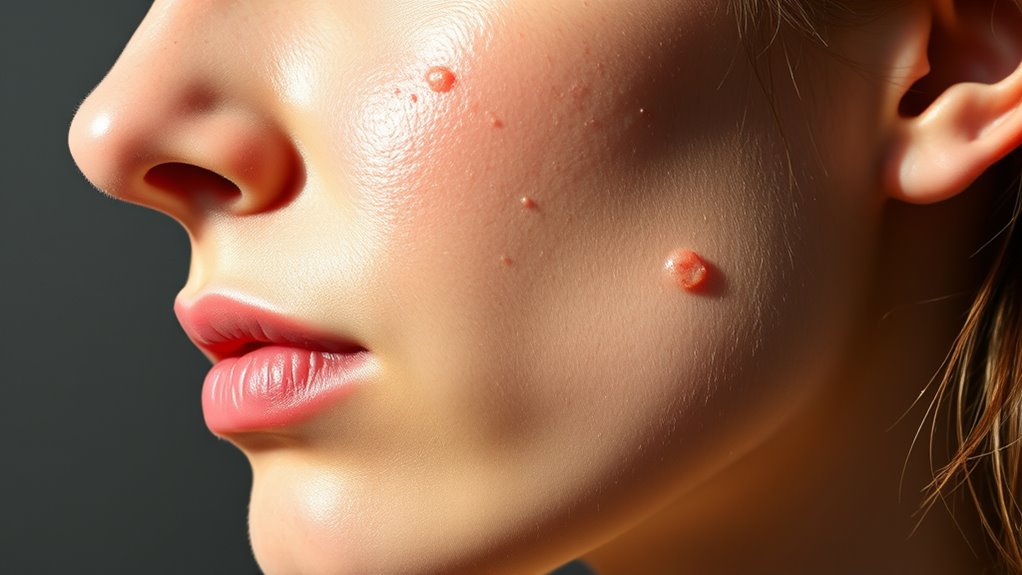
Your genetics can influence how likely you are to develop hormonal acne, especially if family members have experienced similar issues. Women with a family history of PCOS or adult acne often face a higher risk due to inherited hormone sensitivities. Recognizing these genetic factors can help you and your healthcare provider develop a more targeted treatment plan. Additionally, understanding hormonal fluctuations and their impact on skin can further guide personalized skincare approaches.
Genetic Predisposition Links
Genetic predisposition plays a significant role in the development of hormonal acne, especially in women over 40. Your family history can reveal if acne runs in your genes, hinting at a higher risk. Genetic factors influence hormone regulation, making you more prone to imbalances that cause breakouts. If you notice specific patterns—like more severe acne during hormonal shifts—your genetics could be a factor. These inherited traits can also determine how your skin responds to treatments or stress. To picture it:
- Family members with adult acne, suggesting a hereditary link
- Genetic influence on hormone sensitivity, affecting your skin’s reaction
- Inherited skin type traits, impacting how prone you are to breakouts
Understanding your genetic predispositions can help you tailor prevention and treatment strategies more effectively. Recognizing the importance of genetic factors can also motivate you to explore personalized approaches to skincare and hormonal health. Additionally, research shows that hormonal regulation is often impacted by inherited characteristics that affect your body’s response to hormonal fluctuations.
Polycystic Ovary Syndrome
Have you ever wondered how conditions like Polycystic Ovary Syndrome (PCOS) increase the risk of hormonal acne in women over 40? PCOS causes hormonal imbalances, especially elevated androgens, which stimulate oil production and lead to persistent acne. Even as you age, these hormonal fluctuations can continue, making acne more stubborn and difficult to treat. Women with PCOS often experience overlapping symptoms with perimenopause, complicating diagnosis. Elevated androgens not only cause acne but also contribute to oily skin and other skin issues. Managing PCOS-related acne typically involves hormonal therapies like birth control pills or anti-androgens, along with lifestyle changes. Recognizing PCOS’s role in your skin health helps you seek targeted treatments and better control your symptoms over time. Recent studies also indicate that digital literacy programs are encouraging playful communication among seniors, which can help reduce feelings of isolation and support mental health. Additionally, understanding hormonal imbalances in skin health underscores the importance of comprehensive treatment approaches. Furthermore, awareness of the power of electric bikes and related technologies can inspire new approaches to managing daily routines and health. Exploring hormonal regulation strategies can also enhance treatment efficacy and improve quality of life for women dealing with these issues. For example, exploring nutritional strategies may help modulate hormone levels and improve skin outcomes.
The Role of Androgens and Hormone Balance in Acne Formation
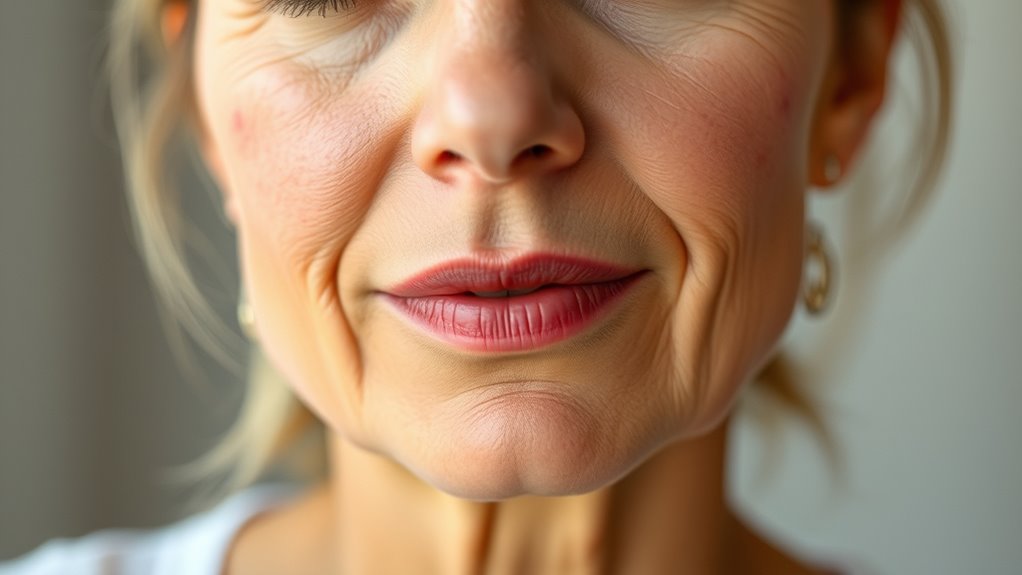
Androgens, like testosterone, increase oil production in your skin, which can clog pores and cause acne. When hormone levels are out of balance, this excess oil and inflammation often worsen breakouts. Restoring hormone balance can help clear your skin and reduce acne flare-ups. Incorporating hormone regulation strategies can support overall skin health and minimize breakouts. Additionally, understanding hormonal fluctuations can help you better anticipate and manage breakouts during different phases of life. Recognizing the impact of hormone imbalance on skin can empower you to seek appropriate treatments and lifestyle adjustments.
Androgens Stimulate Oil Glands
Hormones play a direct role in controlling your skin’s oil production, with androgens like testosterone and DHT acting as key regulators. When these hormones bind to receptors in your sebaceous gland cells, they stimulate the glands to grow larger and produce more sebum. This increased oil output can clog pores and lead to acne. Even normal androgen levels can cause breakouts if your glands are hypersensitive. Local conversion of testosterone to DHT within the skin amplifies this effect, often without systemic hormone changes. Imagine your oil glands as tiny factories that ramp up production when triggered. Research shows that HEPA filtration can help reduce airborne irritants that may worsen skin conditions.
- Sebaceous glands swell and secrete excess oil, filling pores like tiny reservoirs.
- Androgens activate enzymes that boost sebum production right at the follicle.
- This process creates a sticky environment, trapping dead skin and bacteria.
Hormonal Imbalance Triggers Acne
Hormonal imbalances, particularly involving androgens like testosterone, play a central role in triggering acne in women over 40. Elevated or sensitive androgen levels increase sebum production by activating sebaceous glands, leading to clogged pores and breakouts. Even women have androgens, and fluctuations in these hormones—whether from menstrual cycles, perimenopause, or menopause—can worsen acne. These hormonal shifts don’t just influence oil; they also impact inflammation and skin barrier health, making skin more prone to irritation and acne. Conditions like PCOS, pregnancy, or postpartum hormonal changes further disrupt hormone balance, intensifying breakouts. As hormone levels fluctuate or decline, the skin’s response varies, often resulting in persistent or worsening acne well beyond adolescence. Managing these imbalances is key to controlling adult hormonal acne. Additionally, understanding the Gold IRA Markets can help women plan for financial security as they navigate these hormonal changes. Recognizing the importance of hormone regulation can help in developing effective treatment strategies to restore skin health.
Balance Restores Skin Clarity
Balancing androgen levels is essential for maintaining clear, healthy skin in women over 40. When hormones are in harmony, sebum production stabilizes, reducing pore clogging and inflammation. This can lead to a noticeable improvement in skin clarity and fewer breakouts. Imagine your skin with a balanced oil level, pores open and free of blockages, and inflammation minimized.
- Picture your skin’s surface smooth and matte, without excess oil or shine.
- Visualize pores that breathe freely, free from debris and bacteria.
- Envision a calm, resilient skin barrier that resists flare-ups.
Achieving hormonal balance helps keep androgen sensitivity in check, preventing excess sebum. Whether through lifestyle, medications, or topical treatments, restoring this balance can markedly improve your skin’s appearance and health, allowing you to feel confident in your skin again. Glycolic acid can also assist in maintaining clear skin by promoting exfoliation and supporting pore health.
Medical and Topical Solutions for Managing Hormonal Acne
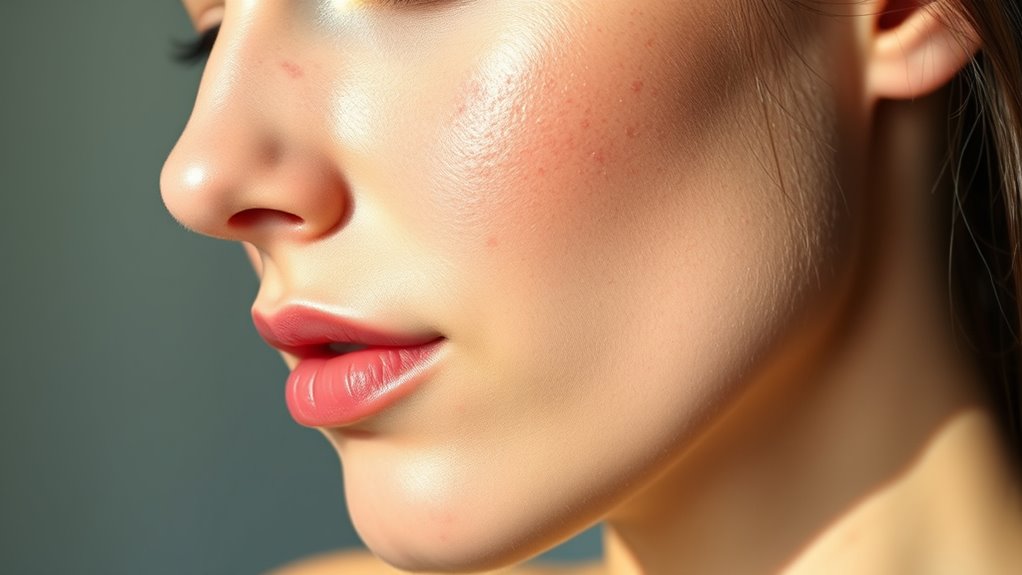
Managing hormonal acne in women over 40 involves a combination of medical and topical treatments tailored to individual skin needs. Medical options include oral contraceptives that balance hormones, anti-androgen drugs like spironolactone to reduce androgen levels, and oral antibiotics to fight bacterial inflammation. For severe cases, isotretinoin may be prescribed. Lifestyle changes such as stress reduction, healthy eating, and regular exercise support treatment. Topical solutions include retinoids like tretinoin and adapalene to promote cell turnover, benzoyl peroxide to kill bacteria, and salicylic acid to unclog pores. Natural remedies like tea tree oil and alpha hydroxy acids help exfoliate and soothe skin. Combining these approaches, along with consistent skincare routines, can markedly improve hormonal acne and restore skin clarity.
Effects of Menopause and Hormone Replacement Therapy on Skin
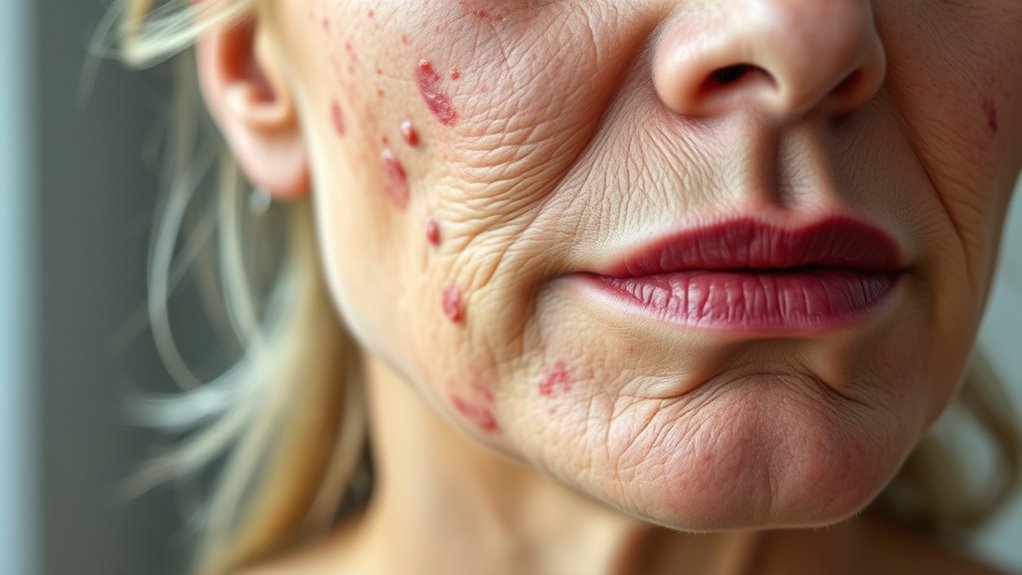
As women go through menopause, declining estrogen levels considerably impact skin health and appearance. You might notice your skin becoming drier, less elastic, and more prone to wrinkles. Reduced collagen and elastin weaken skin structure, leading to sagging and fine lines. Hormone replacement therapy (HRT) can help restore estrogen, potentially improving hydration and firmness. It supports collagen production, which may reduce wrinkles and boost skin strength. With HRT, you might see a more radiant, resilient complexion. Imagine:
Menopause-related estrogen decline can lead to drier, less elastic skin with more wrinkles.
- A smoother, plumper surface with fewer lines
- Hydrated skin that feels soft and supple
- Improved elasticity, making your skin look more youthful
While HRT offers benefits, results vary, and it’s crucial to weigh risks with your healthcare provider. Proper skin care remains important to maintaining your skin’s health during and after menopause.
Lifestyle Strategies to Prevent and Reduce Hormonal Breakouts
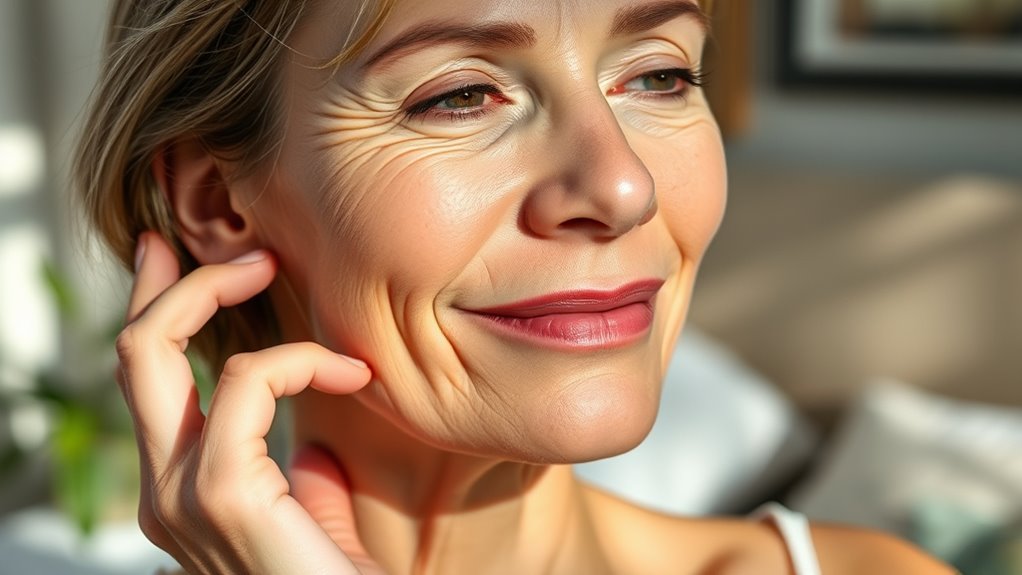
Implementing simple lifestyle strategies can considerably reduce hormonal breakouts and improve your skin’s appearance. Regularly washing your face with a mild soap helps keep pores clear and prevents buildup. Eating a balanced diet rich in fruits, vegetables, and omega-3 fatty acids reduces inflammation, supporting clearer skin. Managing stress through yoga, meditation, or deep breathing calms hormonal fluctuations that trigger breakouts. Staying consistent with exercise promotes hormone balance and overall health. Prioritize quality sleep to regulate hormones and help your skin recover. Hydrate well to flush out toxins, and limit sugar intake to avoid insulin spikes. Incorporate probiotics to support gut health, which influences skin health. By adopting these habits, you can minimize hormonal flare-ups and maintain healthier skin over time.
Tailoring Skincare and Routine Adjustments for Mature Skin
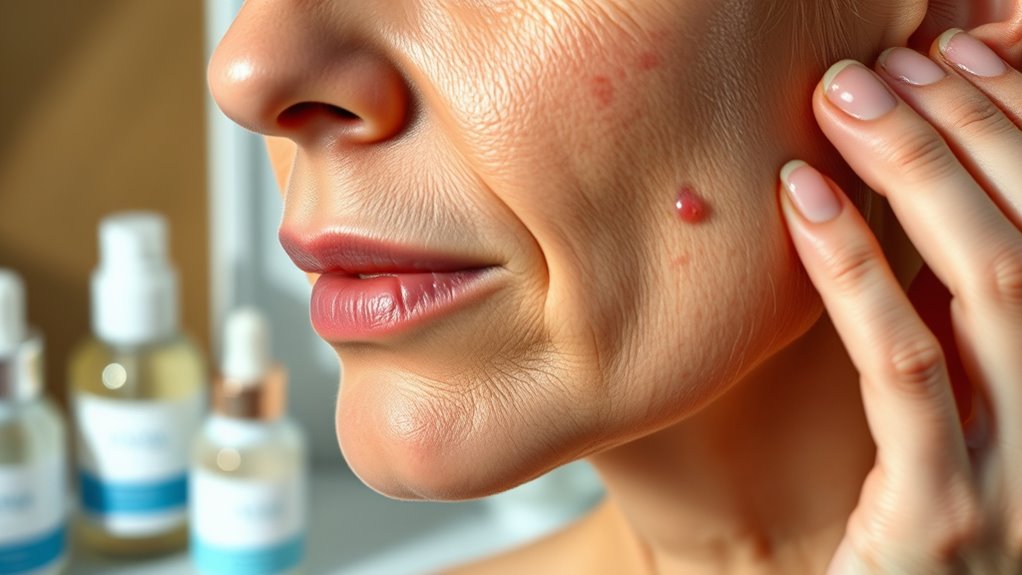
Adjusting your skincare routine to suit mature skin can considerably improve hormonal acne and overall skin health. Focus on gentle, effective products that respect your skin’s changing needs. Use mild cleansers that don’t strip natural oils, and opt for non-comedogenic moisturizers to keep your skin hydrated without clogging pores. Incorporate targeted treatments like retinoids and salicylic acid to boost cell turnover and clear pores. Protect your skin daily with broad-spectrum sunscreen to prevent sun damage and excess oil production. Regular, gentle exfoliation with AHAs helps maintain smooth texture and prevents buildup.
Imagine:
- A soothing, creamy cleanser that gently lifts dirt without drying.
- A lightweight, oil-free moisturizer that locks in hydration.
- A broad-spectrum SPF that feels barely there on your skin.
Frequently Asked Questions
Can Hormonal Acne Persist After Menopause?
Yes, hormonal acne can persist after menopause. Even though estrogen levels drop, androgen levels may stay the same or increase, causing continued oil production and breakouts. Your hormonal imbalance, genetics, lifestyle, and skincare habits all influence whether acne persists. To manage it, you might consider hormonal treatments, topical products, or lifestyle changes. Consulting a dermatologist will help you develop a personalized plan to clear your skin effectively.
Are Hormonal Treatments Effective for Women Over 40?
Hormonal treatments can be effective for women over 40 dealing with acne. You might find options like spironolactone, oral contraceptives, or hormone replacement therapy helpful in balancing hormone levels and reducing breakouts. However, it is crucial to work closely with your healthcare provider to monitor for side effects and determine the best approach. Consistent use and lifestyle adjustments also play a key role in maintaining clear skin.
How Do Diet and Stress Influence Hormonal Acne at This Age?
You should know that your diet and stress levels directly impact your hormonal acne. Eating high-glycemic and dairy-rich foods can spike hormones and insulin, increasing oil production. Stress raises cortisol, which also boosts sebum and worsens breakouts. By reducing stress through relaxation techniques and choosing a balanced diet with fruits, vegetables, and whole grains, you can help regulate hormone levels and improve your skin’s health.
What Are the Best Skincare Ingredients for Hormonal Acne in Mature Skin?
Perfectly pick out powerful skincare ingredients to combat hormonal acne. You should seek soothing niacinamide to calm inflammation and regulate oil. Salicylic acid clears clogged pores, while retinol stimulates skin renewal. Azelaic acid fights bacteria and brightens, and hyaluronic acid hydrates without clogging. Incorporate alpha hydroxy acids for exfoliation, and consider anti-inflammatory options like tea tree and sulfur. Avoid irritating ingredients like heavy oils, fragrances, and alcohol for best results.
Does Hormonal Acne Indicate Underlying Health Issues?
You might wonder if hormonal acne signals underlying health issues. While it often relates to hormonal imbalances like those during menopause or PCOS, it doesn’t always mean something serious. Stress, sleep, diet, and environmental factors can also trigger breakouts. If your acne persists or worsens, it’s wise to consult a healthcare professional. They can check for underlying conditions and recommend appropriate treatments to address both your skin and overall health.
Conclusion
Did you know that up to 50% of women over 40 experience hormonal acne? Understanding how hormonal shifts impact your skin can help you take control. By managing stress, maintaining a balanced diet, and choosing the right treatments, you can reduce breakouts and improve your skin’s health. Remember, addressing hormonal causes early can make a big difference, so don’t hesitate to consult a dermatologist for personalized advice and effective solutions.









